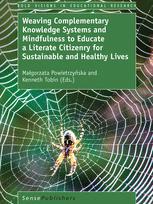

Most ebook files are in PDF format, so you can easily read them using various software such as Foxit Reader or directly on the Google Chrome browser.
Some ebook files are released by publishers in other formats such as .awz, .mobi, .epub, .fb2, etc. You may need to install specific software to read these formats on mobile/PC, such as Calibre.
Please read the tutorial at this link: https://ebookbell.com/faq
We offer FREE conversion to the popular formats you request; however, this may take some time. Therefore, right after payment, please email us, and we will try to provide the service as quickly as possible.
For some exceptional file formats or broken links (if any), please refrain from opening any disputes. Instead, email us first, and we will try to assist within a maximum of 6 hours.
EbookBell Team

4.7
86 reviewsWeaving Complementary Knowledge System and Mindfulness to Educate a Literate Citizenry for Sustainable and Healthy Lives contains 24 chapters written by 33 authors, from 9 countries. The book, which consists of two sections on mindfulness in education and wellness, is intended for a broad audience of educators, researchers, and complementary medicine practitioners. Members of the general public may find appeal and relevance in chapters that advocate transformation in a number of spheres, including K-12 schools, museums, universities, counselling, and everyday lifestyles. Innovative approaches to education, involving meditation and mindfulness, produce numerous advantages for participants in schools, museums, and a variety of self-help contexts of everyday life. In several striking examples, critical stances address a band wagon approach to the application of mindfulness, often by for-profit companies, to purportedly improve quality of education, in contexts where learning has been commodified and ideologies such as neoliberalism have been mandated by politicians and implemented by policy makers. In different international contexts, Buddhist roots of mindfulness are critically reviewed by a number of authors. Chapters on wellness focus on complementary practices, including art therapy, Jin Shin Jyutsu, Iridology, and yoga. Foci in the wellness section include sexual health, prescription drug addiction, obesity, diabetes, cancer, and a variety of common ailments that can be addressed using complementary medicine. New theories, such a polyvagal theory, provide scope for people to become aware of their bodies in different ways and maintain wellbeing through changes in lifestyle, heightened self-awareness, and self-help.